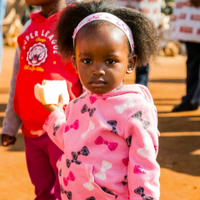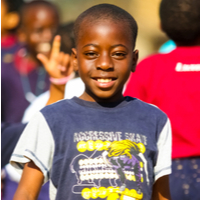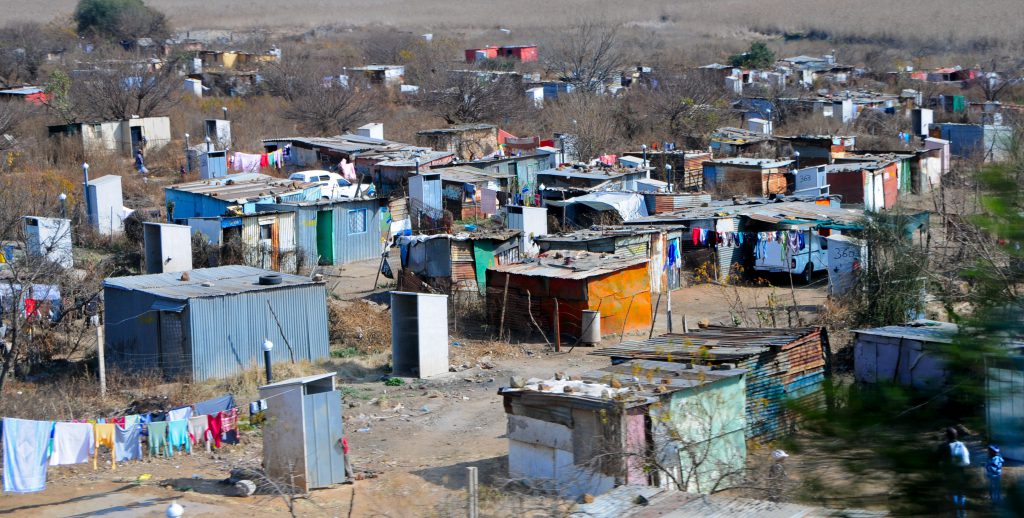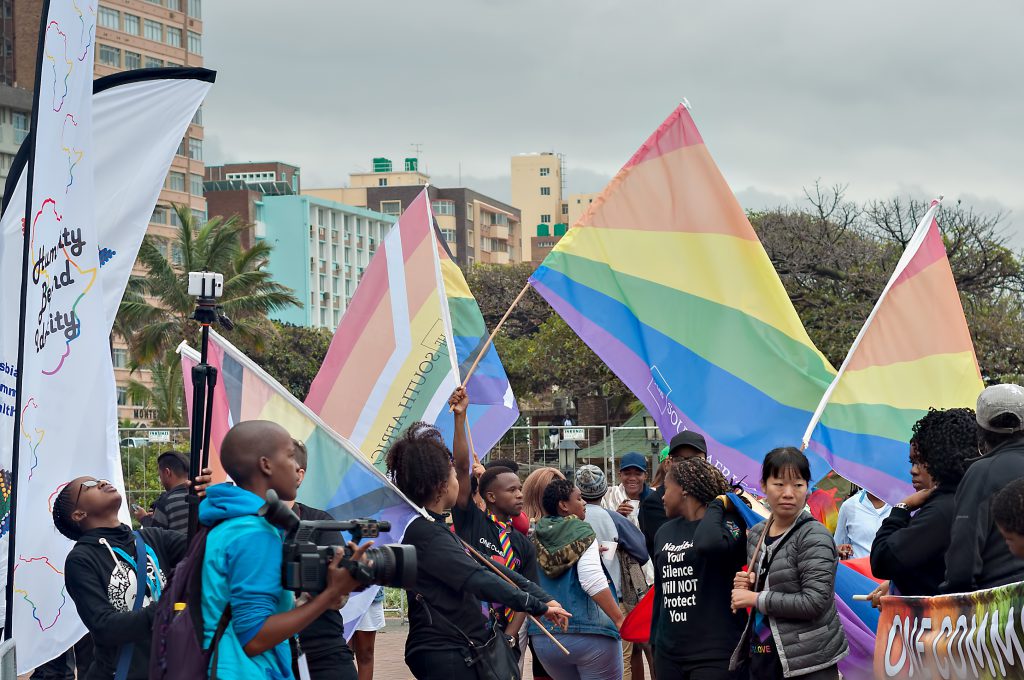Realizing Children’s Rights in South Africa


South Africa ratified the Convention on the Rights of the Child in June 1995. A year later, the South African government-specified children’s rights in the Constitution’s Bill of Rights in Section 28: “every child has the right to basic nutrition, shelter, health care and social services, as well as the right to be protected from maltreatment, neglect, abuse or degradation.” Despite these promises, children of different backgrounds in South Africa are born into very unequal opportunities; some affected by poverty, poor health, and lowered access to education.

Children’s Rights Index: 7,07/10
Red level: Difficult situation
Population: 59.3 million
Population ages 0-14: 28.8%
Life expectancy: 64.1 years
Under-5 mortality rate: 34.5‰
South Africa at a glance
The Republic of South Africa is a country located in Southern Africa and holds a population of 60 million people. South Africa is a developing country with the third-largest economy in Africa. The inequalities existing within this multicultural and multiethnic country stem from the Apartheid era, imposed in 1948 by the National Party, which launched official racial segregation between white and black people.
Anti-Apartheid activists fought to repeal these discriminatory laws by the mid-1980s, and in April 1994, South Africans experienced the first democratic elections, voting in the majority for the country’s first Black president Nelson Mandela. Throughout his term, Mandela paid close attention to children and pushed for his citizens to reach out to children in order to support their growth amidst the pain and suffering. But despite his goals and objectives, the rights of children in South Africa remain neglected.
Status of children’s rights[1]
After Apartheid, Mandela’s government worked to provide adequate support to children. Section 28 of the Bill of Rights outlines children’s right to a safe life:
“Every child has the right to:
- A name and a nationality from birth. Family care or parental care, or to appropriate alternative care when removed from the family environment.
- Basic nutrition, shelter, basic health care services and social services.
- Be protected from maltreatment, neglect, abuse or degradation.
- Be protected from exploitative labour practices.
- Not be required or permitted to perform work or provide services that are inappropriate for a person of that child’s age or risk the child’s well-being, education, physical or mental health or spiritual, moral or social development.
- Not be detained except as a measure of last resort, in which case, in addition to the rights a child enjoys under sections 12 and 35, the child may be detained only for the shortest appropriate period of time, and has the right to be kept separately from detained persons over the age of 18 years.
- Be treated in a manner, and kept in conditions, that take account of the child’s age and have a legal practitioner assigned to the child by the state, and at state expense, in civil proceedings affecting the child, if substantial injustice would otherwise result.
- Not be used directly in armed conflict, and to be protected in times of armed conflict.” (Constitutional Court of South Africa, n.d.)

After the ratification of the UNCRC, South Africa also signed into law the Basic Conditions of Employment Act, which prohibits child labor of children under 15 years of age. (Constitutional Court of South Africa, n.d.)South Africa is also a signatory of the African Charter on the Rights and Welfare of the Child, whose Article 3 recognizes the child’s right to a joyful childhood, regardless of race, ethnicity, sex, religion, or birth status.
In addition, the Domestic Violence Act of 1998 protects children against domestic abusers. The Children’s Bill of 2005, meant to replace the Child Care Act of 1983, provided for children’s right to privacy and protection, and also proposed new funding projects for early childhood development programs. In doing so, these laws aim to provide a holistic approach to children. Despite South Africa’s efforts, children’s rights are still heavily neglected. (Constitutional Court of South Africa, n.d.)
Addressing the needs of children
Right to education
Post-Apartheid, South Africa made great progress in providing the right to education. The progress has been prominent in pre-school, primary, and secondary education.
“The number of children under five attending an Early Childhood Development (ECD) centre or pre-school has increased to one in three from one in ten since 2002. Primary school attendance is at 99 percent – up some 3 per cent since 2002. Secondary school attendance has increased to 90 per cent from 88 per cent in 2002, with notable gender parity. Children with disabilities continue to be better included within the schooling system, now representing 5 per cent of the total population of children attending school.”
– UNICEF South Africa, n.d.
Despite these changes, however, children’s access to quality education remains impacted by poverty and inequality. Without a qualified teaching workforce, quality schooling, and high poverty, children’s access to education prevents them from forming the foundation to a child’s “future development and learning ability.” (UNICEF South Africa, n.d.)
Dropout rates are also significant — more than 25% of children drop out, the majority from poor areas. Girls are particularly over-represented in this statistic, leading to a widening gender gap in schools. Furthermore, the government has promised to waive school tuition costs for the poorest 60% of children – but some families still have to cover the costs of other school-related expenses. (UNICEF South Africa, n.d.)
Young girls are impacted by gender inequality — this gender gap is particularly strong in science, technology, engineering and mathematics (STEM)-related careers, where less than 30% of young girls graduate from tertiary institutions.
In February 2020, Amnesty International published a report on the glaring inequalities in South African schools, impeding on children’s access to education. Amnesty explains that access to good education depends on a child’s wealth, skin color, and location — further perpetuating the political decisions made during the apartheid era. The Executive Director of Amnesty International South Africa, Shenilla Mohamed, hopes the South African government will change its ways.
“The right to quality education includes having a school where learners are safe to learn and have the adequate infrastructure and facilities to do so, but our research has found that this is not the reality for many learners in the country.”
– Amnesty International, 2020
Many schools in South Africa have poor infrastructure and poor sanitation — representing a number of “endemic failings in the system.” (Amnesty International, 2020) Indeed, in 2013, the government put into place the Minimum Norms and Standards to ensure that schools would have good and safe sanitation by 2016, but these goals have not been met. For example, children in South African schools do not all have access to functioning and safe toilets and pit latrines.
The basic facilities are also poorly maintained – often made from dangerous materials such as asbestos which can have detrimental consequences for children’s development. The classrooms are overcrowded and the educational materials are often vandalized. As a result of these conditions, children are not learning properly — more than 3/4 of South African children at the age of nine cannot read for meaning, a statistic which is worse in certain provinces, such as Limpopo (91%), and the Eastern Cape (85%). Out of 100 learners, only 14 are at the level to attend university education. (Amnesty International, 2020)
Access to school is also an issue. Although the Department of Transport promises to offer transportation to school for those living more than 3 kilometers away, some children continue to walk that distance in order to obtain their education. This distance is worse for children living in low-income groups. Mohamed worries about the future impact on children’s growth, both for themselves and for the country.
“The repeated failure of government to address the issues is not only a question of accountability; it has consequences for the life chances of thousands of young people and the future of this country.”
– Amnesty International, 2020
Right to health
Post-Apartheid, South Africa made significant changes in its health sector and provided aid to populations which were previously denied the access to care. The access today remains precarious, and “thousands of children die from treatable and preventable conditions.” (UNICEF South Africa, n.d.) The newborn mortality is high — UNICEF reports that “in 2018 alone, an estimated 43,000 children under five died in South Africa, and of these, 12,717 were newborns.” (UNICEF South Africa, n.d.)
The conditions leading to these deaths — prematurity, birth complications, and neonatal infections — are all preventable and treatable. Malnutrition and obesity also play a role in infant mortality.
“Food scarcity, feeding infrequency and a lack of dietary diversity are serious impediments to healthy levels of child nutrition.”
– UNICEF South Africa, n.d.

Children also live in inadequate housing, and are often less urbanized than adults, which is a particularly important issue as rural life does not offer the same opportunities as urban life. (UNICEF South Africa, n.d.) Close to 2 million children (or 9% of South Africa’s children) are living in informal housing dwellings — shakes in backyards, rooms built of non-durable materials.
For adolescents, HIV/AIDS infections have been particularly detrimental. More than a third of new infections in South Africa “occur between the ages of 15-24 years. Of this group, HIV incidence was three times higher among adolescent girls and young women than their male counterparts.” (UNICEF South Africa, n.d.) Unfortunately, less than 2/3 of children receive antiretroviral therapy treatment. The rates of HIV infections in South Africa point to the larger problem of AIDS in Africa.
Right to water
Katharine Hall, the senior researcher at the Children’s Institute at the University of Cape Town, also points to children’s reduced access to water. – In 2018, close to 6 million children (more than 30% of South African children) lacked clean drinking water. Good sanitation is also lacking.
“During 2018, 79% of South African children had access to adequate toilets, but shockingly 4.2 million children still use unventilated pit latrines, buckets or other inadequate forms of sanitation.”
– Jones, 2020
These conditions have worsened with the COVID-19 pandemic, a time when access to adequate water, soap, and sanitation became vital. Safety measures, such as social distancing was not quite possible in overcrowded households. (Jones, 2020)
Right to nutrition
Nutrition is an important issue in South Africa, where more than half of the children under the age of five are stunted. Overall, almost 3 out of 10 children are stunted, a condition which affects their growth and development “because of the irreversible physical and cognitive damage caused by persistent nutritional deprivations.” (UNICEF South Africa, n.d.) Good nutrition is fundamental to a child’s well-being — malnourishment can lead to infant and child morbidity and mortality, and furthers the vicious cycle of poverty. Compared to other African countries, South Africa has the highest rate of stunting.
Right to identity
Section 28 (1) (a) of the South African Constitution states that children have the right to a name and identity. The Birth and Death Registrations Act copes with the registration of the births of children. (UNICEF South Africa, n.d.) For undocumented migrant children, this is more complex — the Children’s Act 38 of 2005 states that while undocumented migrant children may be processed, their identity may not be registered with South African birth certificates, meaning that when they turn 18, they can become undocumented adults and as a result, deported.
Risk factors → Country-specific challenges
Child labor
The South African government has ratified all the key international conventions on child labor. In 2019, furthermore, South Africa launched the Prevention and Combating of Trafficking in Persons National Policy Framework. Despite these efforts, the Bureau of International Labor Affairs explains that “gaps exist that hinder the effective coordination of efforts to address child labor, including efficacy in accomplishing mandates.” (Bureau of International Labor Affairs, n.d.)
As a result, children in South Africa engage in some of the worst forms of child labor, such as commercial sexual exploitation and forced begging. South Africa is also an important destination country for child trafficking — children from poor rural areas are trafficked to urban cities such as Cape Town, Durban and Johannesburg. The high poverty in the country often leads refugee children, orphan children, and children with disabilities vulnerable to the worst forms of child labor.
More than 40% of children in South Africa, in general, are poor and income-poor, and two-thirds of children in rural areas are poor and income-poor. More than 50% of children in South Africa live below the poverty line. (UNICEF South Africa, n.d.)
Violence
Children suffer from South Africa’s violent past — stemming also from high poverty and unemployment. Children need more protection as abuse and neglect become more normalized in societal life. UNICEF points to four major problems.
First, children are left without parents due to HIV and secondly, South Africa is an important destination for refugees, but their children often face discrimination. Also, gender-based violence is an ongoing emergency since young girls suffer numerous forms of sexual violence, often from people in their circle. Finally, with the digital turn, children are also being cyberbullied. (UNICEF South Africa, n.d.) Overall, children are in deep need of protection from violence in South Africa.
Child marriage
Child marriage is illegal in South Africa as it violates the specifications of the Constitution’s Bill of Rights, the Children’s Act of 2005, and the Recognition of Customary Marriages Act 120 of 1998 in 2000 (Mtshali, 2014). Nonetheless, the language used in the latter document does not specifically protect young girls who cannot give consent if their parents agree on their behalf. As such, forced child marriage in South Africa is practiced under the pretext of customary marriage, most predominantly by the Zulu and the Bapedi. (Mtshali, 2014)
These practices are deemed culturally acceptable, but they are highly dangerous for girls’ mental and physical development, robbing young girls of their fundamental human right to a safe, healthy, and protected childhood. Sub-Saharan and Southern Africa have high rates of child marriage — in South Africa alone, 6% of girls marry before they turn 18. (Grobler, 2019) James Elder, UNICEF’s Eastern and Southern Africa Chief of Communication, warns that the figure may be higher, as many cases of child marriage are under-reported. UNICEF’s Executive Director Henrietta Fore describes it best: “marriage steals childhood.” (Grobler, 2019) Child marriage deprives children of their childhood, happiness, and opportunities. (Grobler, 2019)
Discrimination against LGBTQ children

South Africa is the only country in Africa where same-sex marriage is legal and was the fifth country in the world to outlaw discrimination based on sexual orientation. Furthermore, the Bill of Rights outlaws discrimination on the basis of sexual orientation, “promising full citizenship to a post-apartheid generation of young LGBTIs.” (Smaak and Varia, 2015) Moreover, South Africa has a gay radio station – Gay SA Radio — which helps to break down stereotypes and provides a voice for those struggling to accept themselves. It is a way of bringing visibility to LGBTIQ youth. (Hird, 2021) Nonetheless, young LGBTIQ children are exposed to continuing homophobia everywhere in society, and governments have failed to address this discrimination.
Written by Leah Benque
Last updated on 4 August 2021
References:
[1] This article by no means purports to give a full or representative account of children’s rights in South Africa; indeed, one of many challenges is the scant updated information on South African children, much of which is unreliable, not representative, outdated or simply non-existent.

